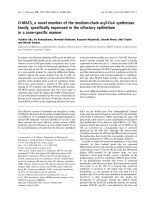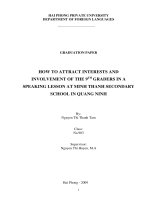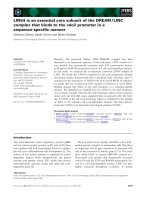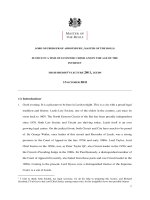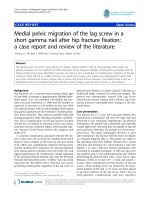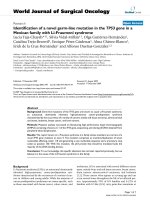The assessment of the fragrant trait in a collection of vietnamese rice landrace varieties
Bạn đang xem bản rút gọn của tài liệu. Xem và tải ngay bản đầy đủ của tài liệu tại đây (1.41 MB, 62 trang )
VIETNAM NATIONAL UNIVERSITY OF AGRICULTURE
FACULTY OF BIOTECHNOLOGY
-------------***-------------
GRADUATION THESIS
“THE ASSESSMENT OF THE FRAGRANT TRAIT IN A
COLLECTION OF VIETNAMESE RICE LANDRACE
VARIETIES”
Hanoi - 2021
VIETNAM NATIONAL UNIVERSITY OF AGRICULTURE
FACULTY OF BIOTECHNOLOGY
-------------***-------------
GRADUATION THESIS
“THE ASSESSMENT OF THE FRAGRANT TRAIT IN A
COLLECTION OF VIETNAMESE RICE LANDRACE
VARIETIES”
Student’s name
: Vu Manh An
Class
: K61CNSHE
Faculty
: Biotechnology
Supervisor
: Dr. Hoang Thi Giang
Dr. Nguyen Thi Lam Hai
Hanoi - 2021
STATEMENT OF ORIGINAL AUTHORSHIP
The work contained in this thesis has not been previously submitted to meet
requirements for an award at this or any other education institution. To the best of my
knowledge and belief, the thesis contains no material previously published or written
by another person except where due reference is made.
Hanoi, February 23rd, 2021
Student
Vu Manh An
i
ACKNOWLEDGMENTS
This thesis, like any other, would not have been possible without the
involvement and support of many people. They have all earned my deepest gratitude,
even if it has been poorly expressed at times.
First and foremost, my sincere thank gives my academy supervisor, Dr. Hoang
Thi Giang, for her enthusiastic support and useful suggestions for my graduation
thesis. Secondly, I would like to express my thankfulness to Dr. Nguyen Thi Lam Hai
for guiding me to carry out my tasks in the Faculty of Biotechnology at Vietnam
National University of Agriculture. Without them, this project would not have been
possible.
Next, I would like to thank to all staff at International joint laboratory on
Functional Genomics & Biotechnology for Plants and Associated Microorganisms
(LMI RICE-2), Agricultural Genetics Institute who have stood by me for a long period
of time for completing my graduation thesis and shared me a number of worthy
working experiences. They are all friendly and helpful to me, I was lucky to study in a
great working environment.
Last but not least, I want to thank my family and friends for all their help,
encouragement and supporting me over the past years.
Hanoi, February 23rd, 2021
Student
Vu Manh An
ii
CONTENTS
STATEMENT OF ORIGINAL AUTHORSHIP .............................................................i
ACKNOWLEDGMENTS .............................................................................................. ii
CONTENTS .................................................................................................................. iii
THE LIST OF TABLES ..................................................................................................v
THE LIST OF FIGURES ...............................................................................................vi
THE LIST OF ABBREVIATIONS.............................................................................. vii
ABSTRACT ................................................................................................................ viii
PART I. INTRODUCTION ............................................................................................ 1
1.1. Preface ......................................................................................................................1
1.2. Objectives .................................................................................................................2
1.3. Requirements ............................................................................................................2
PART II. LITERATURE REVIEW ................................................................................3
2.1. Rice grain quality .....................................................................................................3
2.1.1. Milling quality .......................................................................................................3
2.1.2. Appearance quality ................................................................................................ 4
2.1.3. Cooking and eating quality ....................................................................................5
2.1.4. Nutritional quality .................................................................................................6
2.2. The fragrant trait in rice ............................................................................................ 7
2.2.1. Fragrance in rice ....................................................................................................7
2.2.2. Origin and diversity of fragrant rice varieties .......................................................8
2.2.3. Genetic basis of fragrance on rice .......................................................................11
2.3. Molecular breeding of fragrant rice ........................................................................13
2.3.1. Marker-assisted selection ....................................................................................13
2.3.2. Breeding of the fragrant rice in the world and in Vietnam .................................14
PART III. MATERIALS AND METHODS .................................................................16
3.1. Materials .................................................................................................................16
3.1.1. Plant materials .....................................................................................................16
3.1.2. PCR-based molecular markers ............................................................................16
3.2. Research contents ...................................................................................................17
3.3. Location and time ...................................................................................................17
iii
3.4. Research methodology and techniques ..................................................................17
3.4.1. The sensory assessment method of fragrance .....................................................17
3.4.3. Identification of mutation types of Badh2 gene associated with fragrance by
using functional markers ............................................................................................... 18
PART IV. RESULTS AND DISCUSSION ..................................................................20
4.1. Evaluation of fragrance for the collection of Vietnam rice landrace varieties.......20
4.2. Identification of mutation types of Badh2 gene associated with fragrance in the
collection of Vietnamese rice landrace varieties by using functional markers .............24
4.2.1 Total genomic DNA extraction ............................................................................24
4.2.2. Marker badh2-E7 .................................................................................................25
4.2.4. Marker badh2-E2 .................................................................................................33
4.2.3. Marker FMbadh2-E4-5 ........................................................................................ 34
4.3. The selection of promising high-quality fragrant local rice varieties for rice
breeding program...........................................................................................................36
PART V. CONCLUSION AND PROPOSALS ............................................................ 39
5.1. Conclusion ..............................................................................................................39
5.2. Proposals .................................................................................................................40
PART V. REFERENCES .............................................................................................. 41
APPENDIX ...................................................................................................................47
iv
THE LIST OF TABLES
Table 2.1. Some common fragrant rice cultivars of the world (Pachaurl et al., 2010) ...8
Table 3.1. List of the molecular markers used in this study..........................................17
Table 3.2. The criteria for assessing fragrance (IRRI, 2013) ........................................18
Table 4.1. Fragrance score of the Vietnamese rice landraces collection ......................21
Table 4.2. The statistic result of the fragrant test by the sensory evaluation ................24
Table 4.3. PCR results for checking mutations in Badh2 gene .....................................26
Table 4.4. List of promising varieties for rice breeding program .................................38
v
THE LIST OF FIGURES
Figure 2.1. Images of rice kernels milled with the three indicated laboratory mills
showing the effect of each machine on the shape and size of milled rice kernels
(Bautista & Siebenmorgen, 2002) ...................................................................................4
Figure 2.2. Genetic diversity of appearance quality ........................................................5
Figure 2.3. Major fragrant rice growing regions in Asia.................................................9
Figure 2.4. Structure of fragrance gene and the three functional sites in rice ...............13
Figure 3.1. Field experiment to obtain new grain source ..............................................16
Figure 4.1. Preparation of samples for sensory evaluation of fragrance ....................... 20
Figure 4.2. Electrophoresis of extracted total genomic DNAs......................................25
Figure 4.3. PCR banding patterns for functional marker badh2-E7 .............................. 26
Figure 4.4. PCR banding patterns for functional marker badh2-E2 .............................. 34
Figure 4.5. PCR banding patterns for functional marker FMbadh2-E4-5 ....................35
vi
THE LIST OF ABBREVIATIONS
Abbreviations
Meaning
2AP
2-acetyl-1-pyrroline
AAS
Atomic absorption spectroscopy
BADH2
Betaine aldehyde dehydrogenases 2
BRR
Brown rice recovery
EAP
External Antisense Primer
ESP
External Sense Primer
HRR
Head rice recovery
ICP-MS
Inductively coupled plasma-mass spectrometry
ICP-OES
Inductively coupled plasma-optical emission spectrometry
IFAP
Internal Fragrant Antisense Primer
INSP
Internal Non-fragrant Sense Primer
InDels
Insertion / Deletions
LIBS
Laser-induced breakdown spectroscopy
MAS
The molecular-associated markers
MRR
Milled rice recovery
RNAi
RNA interference
XRF
X-ray fluorescence spectrometry
vii
ABSTRACT
Fragrance is the immensely important criterion in the assessment of rice quality,
is known to be controlled by loss-function of the Badh2 gene. In this study, a
collection of 182 Vietnamese rice landrace varieties was screened for fragrance by
sensory test and genotyped for three major mutation types of Badh2 gene using
functional markers. A total of 18 fragrant varieties were identified, and 13 of them
were confirmed by the presence of 8-bp deletion mutation in exon 7 and/or 803-bp
deletion mutation between exons 4 and 5. Two detected mutation types were present in
some non-fragrant rice varieties, and absent in some fragrant rice varieties. No any rice
varieties were determined to possess 7-bp deletion mutation in exon 2. The results
suggest that these 13 local rice landrace varieties could be potentially provided as
genetic resources in breeding for fragrant rice varieties or could be reintroduced in
production.
viii
PART I. INTRODUCTION
1.1. Preface
Rice (Oryza sativa L.) is the most important human food crop in the world,
consumed by people more than any other crop. Moreover, it is also the main food
across Asia, where around half of the world‟s poorest live, and is becoming essential
food in Africa and Latin America.
Nowadays, since life conditions of people worldwide are improving, the
human‟s requirement of rice quality is gradually enhancing. Among different factors,
fragrance is said to be one of a key constitutes for choosing high-quality rice varieties.
This, therefore, inspires many researchers to study genetic analysis of rice fragrance
and to include this trait as one of the selecting targets in modern rice breeding
program. In Vietnam, fragrant rice landraces are mostly distributed in Northern and
Southern. There are some well-known breeds located in Southern such as Nang thom
cho Dao, Nang huong, Tau huong, and in Northern such as Tam thom, Tam
xoan,…These are very valuable rice resources, which should be conserved and
exploited reasonably.
It has been found hundreds of fragrance-forming chemicals in rice which are
often volatile compounds, for instance hydrocarbon, alcohol, aldehydes, esters,
ketones… (Yajima et al., 1978; Widjaja et al., 1996; Ma Thai Hoa and Le Ngoc
Thach, 2011). Among them, 2-acety-1-pyrroline (2AP) plays the most integral role in
forming the fragrant trait in all fragrant rice breeds (Buttery et al., 1982; 1983; Paule et
al., 1989; (Laksanalamai and Ilanganntileke, 1993). The content of 2AP in fragrant
rice breeds is approximately 0,09 mg/kg, 10 times higher than non-fragrant ones
(0,006-0,008 mg/kg) (Buttery et al., 1983).
It was shown that a recessive gene on chromosome 8 encoding an enzyme
named betaine aldehyde dehydrogenases 2 (BADH2) makes a large impact on
biosynthesis of 2AP (Bradbury et al., 2005a). The functional BADH2 protein inhibits
the biosynthesis of 2AP in non-fragrant rice (Chen et al., 2008), and non-functional
alleles of BADH2 result in the accumulation of 2AP in fragrant rice (Chen et al., 2008;
Niu et al., 2008). The major allelic variations of Badh2 gene were reported to be
strongly associated with fragrance, including an 8-bp deletion in exon 7 (Bradbury et
1
al., 2005a), a 7-bp deletion in exon 2 (Shi et al., 2008), an 803-bp deletion between
exons 4 and 5 (Shao et al., 2011).
Up to now, there are a variety of methods to detect mutation types of Badh2
gene, therefore, the molecular-associated markers (MAS) have recently been used.
Scientists have been developing molecular markers to assist breeders in their selection
for fragrance. In the past years, rice breeding programs in Vietnam have made a
significant progress with numbers of high-quality rice varieties released, but the
genetic diversity of Badh2 gene in fragrant rice varieties has not been published. Rice
merchandises from neighboring countries, such as Thailand, China are the direct
opponents to Vietnam‟s on this competitive market.
Because of those challenges along with a hope of contributing in improving the
quality of Vietnamese‟s rice and the development of Root team at LMI-RICE, I, under
instructions of Dr. Hoang Thi Giang and Dr. Nguyen Thi Lam Hai, made a decision to
conduct a project titled “Genetic diversity assessment of fragrant trait in a collection
of Vietnamese rice landrace varieties”.
1.2. Objectives
The aim of the project is to characterize a collection of 182 Vietnamese rice
landrace varieties for phenotypic and genetic diversity of fragrant trait using sensory
test and molecular markers.
1.3. Requirements
-
To evaluate fragrance of the collection of Vietnamese rice landrace varieties.
-
To identify mutation types of Badh2 gene associated with fragrance in the
collection of Vietnamese rice landrace varieties by using functional markers.
-
To select promising high-quality fragrant local rice varieties for rice breeding
program.
2
PART II. LITERATURE REVIEW
2.1. Rice grain quality
2.1.1. Milling quality
According to the book Rice Chemistry and Technology (2018) of Jinsong Bao,
rice milling is the process that helps to remove of hulls and brans from paddy grain,
produce polished rice and plays a key role in determining rice quality and value. To
meet the consumer‟s preference, rough milling is an important step in which rough rice
is milled to produce milled or polished grain. Whereby, the hulls and bran of dried
rough rice (about 14% moisture) are removed, and the breakage of polished grain
reaches minimum degree. On commercial scale, the milling system includes several
processing stages where the rough rice is first subjected of to de-husk for removal of
husk. Then in order to remove the bran layers and provide surface gloss to the edible
white portion, polishing is carried out (Bao, 2018).
The evaluation for the quality and efficiency of the milling process is based on
three main parameters: brown rice recovery (BRR, the percentage of brown rice to
rough rice), milled rice recovery (MRR, the percentage of milled rice to rough rice),
and head rice recovery (HRR, the percentage of head rice to rough rice) (Bao, 2018).
The terms of percentage of yield of brown rice, milled rice, and head rice are
synonymous as BRR, MRR, HRR, respectively. In 2002, the evaluation between three
lab mills (IRRI Test tube Mill, Kett Polisher, and McGill No.2 Mill) about bran
removal and HRY has revealed The IRRI Test tube Mill requires longer milling
durations to attain desired bran removal and uses a gentle milling action, so it is more
effective than the Kett Polisher and is comparable to the McGill No. 2 Mill (Figure
2.1) (Bautista and Siebenmorgen, 2002).
3
Figure 2.1. Images of rice kernels milled with the three indicated laboratory mills
showing the effect of each machine on the shape and size of milled rice kernels
(Bautista & Siebenmorgen, 2002)
Factors affecting the milling quality of rice are genotypic difference among rice
cultivars, environmental factors during rice growing, milling machineries (devices),
and milling technologies (Bao, 2018). Furthermore, the variety of genetic
characteristics caused by different genotypes is considered the most important factor
affecting milling quality. In other words, milling quality is genetically controlled and
could be improved by breeding. Therefore, high HRY is a high-priority objective for
rice breeding programs (Nelson et al., 2011).
2.1.2. Appearance quality
Currently, the rice market becomes more and more competitive. Consumers
have many criteria to select the desirable-quality rice, especially about the visual
characters of rice grains like grain dimensions, chalk, color and whole grain recovery.
Beside, appearance quality plays an important role in evaluation and pricing rice
varieties on market. Thus, it is necessary to have the accurate information of rice
appearance quality. According to Zhou et al. (2019), a rice grain consists of hull
(lemma and palea), bran layers (pericarp, aleurone, subaleurone layers), embryo, and
endosperm. The most common bran layer for rice is brown, so it is called “brown rice”
when removing the hull (Fig 2.2 A). The outer layer of natural brown bran is stripped
off to create “white rice”, removing most of the fiber, vitamins, minerals, and amino
acids. When bran layers and embryo are removed during the polishing process, it will
become “white rice” and be the general consumed form of rice (Fig 2.2 B). The
physical properties of rice include grain size and shape, chalkiness, translucence, and
color. Grain size includes grain length, width, and thickness, grain shape is determined
4
by grain length and width. Indica rice is supposed to has a long and slender shape
while japonica rice has a short and round shape, however, short or and slender grains
are preferred in some cases, such as the short slender variety Samba Mahsuri, which is
extremely popular in Southern India (Sundaram et al., 2008).
Figure 2.2. Genetic diversity of appearance quality
A: Brown rice with different colors; B: White rice with different grain shape and size. Scale
bar represents 3 mm; C: Three kinds of chalkiness in rice (Zhou et al., 2019)
2.1.3. Cooking and eating quality
In contrast to other staple cereals like wheat and maize that are consumed after
the grain is ground to flour, rice is mainly used as polished grain. Therefore, the
quality characters of rice grain assume greater importance. Champange et al. (2004)
indicated the chief component of milled rice grain is starch which constitutes
approximately 78% (14% moisture) or 90% (dry weight) of the endosperm. Thus, the
properties of starch have main contribution on determining the cooking and eating
quality of rice grains. To determine the cooking and organoleptic properties of rice
grain, three important traits of starch that should be followed are apparent amylose
content (AAC), gelatinization temperature (GT) and gel consistency (GC) (Sharma
and Khanna, 2020).
AAC of starch has been known as taking up from 0.8 to 1.3% in waxy rice,
whereas it makes up 37% in non-waxy rice (Champagne, 2004), the rest is
amylopectin. In addition, AAC is supposed to be directly proportional to indices such
as cohesiveness, tenderness, stickiness and glossiness of cooked rice, thus, based on
5
the AAC value, rice can be classified as waxy (0-2%), very low (3-9%), low (1019%)., intermediate (20-25%), and high (>25%) (Champagne et al., 1999).
Additionally, another index which has been tested complementarily to make
clear many such differences between rice varieties in rice is called Gel consistency
(Cagampang et al, 1973). The purpose of this test is to clarify how the dissimilarity of
GC values between rice varieties is related to the proportion of amylose solubility in
hot water, particularly between hot water soluble amylose compared to insoluble
amylose. Based on the document provided by IRRI (2013), the GC index is showed up
through the length of flour gel after being processed with hot water and there are three
of groups published to classify rice varieties: hard and very flaky (≤ 40mm), medium
and flaky (41-60mm) and soft (>61mm). It is said that the varieties with higher
proportion of hot water insoluble feature exhibit hard GC (Bhattacharya, 2009;
Bhattacharya et al., 1978). Besides, some studies have demonstrated that long-chain
amylopectin that remains in the gelatinized starch granule is probably the hot water
insoluble amylose (Takeda et al., 1987; Horibata, 2004). According to Matsue et al.
(1994), amylose and protein content, amylose-graphic characteristics and even
palatability showed significant difference depending on the position of spikelet in a
panicle.
2.1.4. Nutritional quality
Rice is consumed as a staple for providing sustenance to its consumers. As
starch is the main constituent of milled rice grain, it is the major source of energy.
Apart from starch, the other major macronutrients present in milled rice grain are
storage proteins (7%), storage lipids (<1%) and non-starch polysaccharides (NSPs,
trace amounts). These macronutrients significantly affect the nutritional quality,
textural and sensory traits, and functional properties (Butardo et al., 2016) even though
they constitute minor components of milled rice grain. Storage proteins are major
amino acid composition (Shih, 2004). The Kjeldahal method with modifications to
accommodate smaller sample size (AACCI Method 46-13.01) is a widely used method
for the estimation of total proteins. Individual amino acids can be quantified after acid
hydrolysis using pre-column derivatization with a fluorescent derivatizing reagent
followed by HPLC separation (Cohen, 2000). Lipids serve nutritional and functional
6
role. They provide protection against cardiovascular diseases and cancer (Godber et
al., 2004) and also affect the pasting properties. Crude fat in grains is routinely
analyzed using a standard method (AACCI Method 30-10.01). The fatty acid
composition of the bran layer can also be analyzed using gas-liquid chromatography
(GLC) (Lugay et al., 1964). NSPs are concentrated in the bran layer and only trace
amounts are detected in the milled rice grains but have nutritional importance because
of their unique composition compared to other cereals (Jenkins et al., 1981)
Nutritional components such as minerals, vitamins and phytochemicals are
concentrated in the bran layer and are either absent or present at low levels in milled
grains. So increasing nutrients levels in rice would provide a significant nutritional
boost to the hundreds of millions of people who depend on it. One way to approach
this is by evaluating the available germplasm lines of micro nutrient content for
breeding programs. Micronutrients are being quantified by using atomic absorption
spectroscopy (AAS), X-ray fluorescence spectrometry (XRF), inductively coupled
plasma-mass spectrometry (ICP-MS) laser-induced breakdown spectroscopy (LIBS),
and inductively coupled plasma-optical emission spectrometry (ICP-OES) (Hansen et
al., 2009; Wheal et al., 2011)
2.2. The fragrant trait in rice
2.2.1. Fragrance in rice
Nowadays, consumers care more and more about good quality rice to serve for
daily meals, and fragrance is known to be one of the most important characteristics of
rice. Hence, aromatic or fragrant rice is sold at a premium price in local and
international markets. Among them, two of the most well-known varieties with
fragrant in the world are Jasmine rice of Thailand and Basmati rice of India. These rice
varieties are very popular in Asia (Baishya et al., 2000) and also have wider
acceptance in Europe (Berner and Hoff, 1986), Australia (Reinke et al., 1991), USA
and the Middle East (Shobha Rain et al., 2006). During the period of 33 years, there
were a number of projects or researches conducted to detect compounds involved in
formation of fragrance in rice. For example, the fragrance compounds in scented rice
were identified such as hydrogen sulfide, ammonia and acetaldehyde in the volatile of
cooked rice (Obata et al., 1965). Later, several chemical compounds were found in
7
cooked and uncooked rice (Ayano and Furuhashi, 1970). Nevertheless, the chemical
nature of fragrant formation in rice had not uncovered until 1982, the public of Ron
Buttery with his co-workers revealed that they were successful of cracking the
fragrance and finding out the chemical compound 2-1pyrroline (2AP) as the main
fragrance compound that is responsible for the pleasant fragrance in scented rice
(Buttery et al., 1982). Some researches had indicated that the universality of this
molecule was confirmed by subsequent rice fragrance analyses in several fragrant
varieties worldwide (Buttery et al., 1982; Buttery et al., 1986; Buttery et al., 1988; Lin
et al., 1990). The wide variety of the molecules related to fragrance opened a new door
for researchers to go further its biosynthetic, genetic, molecular and synthetic aspects.
There were many studies referring to more than 100 volatiles from fragrant rice grains
and their contributions to the rice fragrance.
2.2.2. Origin and diversity of fragrant rice varieties
According to Pacahuri et al. (2010) in the 16th century AD, particularly during
the regimes of the Mughals, it was the time that fragrant rice had been more common
in some regions in the world and that was also mentioned in the book „Ain-I-Akbari‟
written by Abul Fazal Allamin around c.1590 AD (Blochman, 1993; Jarret, 1993). In
addition, many evidences or records were counted in the ancient India literature, which
reinforced the belief strongly that the origin of fragrant rice varieties were from India.
All these historical accounts were the most obvious basis to state it is safe to assume
the possible origin and cultivation of fragrant rice in India. Besides, fragrant rice
varieties have been found in many parts of the world and they varied in intensity and
type of fragrance (Figure 2.3, Table 2.1).
Table 2.1. Some common fragrant rice cultivars of the world (Pachaurl et al., 2010)
No
Countries
Name of cultivars
1
Afghanistan
Barah, Lawangin
2
Bangladesh
Badshahbhog, Chinigura, Kala, Namak, Kalijira,
Kataribhog, Radhuni Pagal, Sakkoknora
3
Cambodia
4
China
Somali
Xiang Keng 3, Xiang Nuo 4, Zhao Xing 17
8
No
Countries
5
India
Name of cultivars
Type 3, Basmati 370, Taraori Basmati, Pusa Basmati 1,
Pusa Basmati, Pusa Basmati 1, Pusa Basmati 1121,
CRS30, Kalanamak, Kalajeera, Badshahbhog, Dubraj,
Ambemohar, Sonachur, Tilak Chandan.
6
Indonesia
7
Iran
Mentek Wangi, Rojolele, Sukanandi
Dom Siah, Gerdeh, Hassani, Hassan Sarai, Mehr, Mirza,
Anbar-boo, Mosa Tarom, Sadri, Salari
8
Iraq
9
Japan
10
Myanmar
Anbarboo
Miyakaori, Iwaga, Sari Queen, Kouikuka 37
Balugyun, Boke Hmwe, Nama Tha Lay, Ngakywe,
Pawsan Hmwe, Taungpyan Hmwe
11
Nepal
Brahmphool, Jetho Budho, Rato
12
Philippines
Azucena, Milagrosa, Milfore 6
13
Thailand
Hawm Klong Luang, Hawm Mali, Hawm Supanburi, Jao
Mali, Khao Dawk Mali, Khao Mali, Nahng Nuan, RD 15,
RD6, Som Hong
14
Vietnam
Di Huong, Nang Huong Ran, Nang Thom Cho Dao, Nang
Thom Muong, Nep Bac, Nep Hoa Vang, Nep Rong, Tam
Canh, Tam On, Tam Xoan, Tam Xuan Hai Hau
Figure 2.3. Major fragrant rice growing regions in Asia
9
Regions in red indicate the areas where fragrant rice varieties are cultivated, whereas the
countries where exact location of cultivation is not documented are indicated by dots
(Pachaurl et al., 2010)
Among these, Basmati is a special quality fragrant rice cultivated extensively in
the Indian subcontinent. The name Basmati itself means “the fragrant one” in Hindi,
and it is often designated as the king of rice. It has characteristic long slender grains
with pleasant fragrance along with high volume expansion, linear kernel elongation
with minimum breath wise swelling upon cooking, fluffiness, unique taste and longer
shelf life. Traditional Basmati varieties are tall, prone to lodging and relatively low
yielding, but produce high-quality grains and fetch premium price creating a billiondollar export industry. Authentic basmati rice cultivation is confined primarily to the
Indo-Gangetic Plains of the Indian sub-continent and the foothills of Himalayas with
India being the largest producer and exporter (Pachaurl et al., 2010).
Most of the fragrant rice varieties predominant in the foothills of Hymalayas
and Indo-Gangetic plains, including Basmati and short grain fragrant rice varieties,
belong to group V (Aromatic) of the six major rice groups defined on the basis of
isoenzyme analysis (Glaszmann, 1987). Apart from these, there are many fragrant
varieties of South-East Asia and China that belong to the Group I (Indica) including
the famous Thai Jasmine rice. Some fragrant rice varieties from Indonesia, the
Philippines and China also belong to the iso-enzyme group VI (Japonica). Aromatic
rice varieties belong to group V (Aromatic) of the six major rice groups defined on the
basis of isozyme analysis (Glaszmann, 1987). Apart from this there are many fragrant
varieties of South – East Asia and China that belong to the Group I (Indica) including
the famous Thai Jasmine rice. Some fragrant rice varieties from Indonesia, the
Philippines and China also belong to the isozyme group VI (Japonica). Aromatic rice
varieties found in Italy, France and some other regions of Europe are believed to have
been introduced from Asia when European convoys reached South and South-East
Asia Several hundred years ago.
Diversity of fragrant rice varieties has evolved over thousands of years as local
farmers selected different types to suit their local cultivation practices and needs. It has
been reported that the allele for fragrance was presented in the wild rice and later
10
appeared in some cultivars because such genotypes were preferentially selected by the
local farmers during the process of domestication in early periods (Prathepha, 2008).
This process of selection has resulted in fragrant rice varieties adapted to a wide range
of agro-ecological conditions. That is why most of the rice growing countries around
the world have their own traditional fragrant rice landraces and varieties. The content
and quality of fragrance among these genotypes vary moderate to very high (Mittal et
al., 1995).
In Vietnam, cultivation of fragrant rice is limited to a few areas. The fragrance
expression of these varieties are specific to certain geographic areas. For instance,
Nang Thom Cho Dao expresses fragrance only when it is grown in Can Duoc and
Long An area in the Meckong Delta. Another fragrant variety, Tam Xoan expresses its
fragrance only when grown in the Red River delta. However, Nep Hoa Vang, a
slightly fragrant variety, has the capability to maintain its fragrance without depending
on where it is grown. During 1980s, Basmati 370 from India and Khao Dawk Mali 105
from Thailand were introduced to Vietnam and tested on different growing locations
of Mekong Delta. Basmati 370 was not able to maintain its fragrance and the yield was
also low, hence it was used as patent in cross-breeding programs. Khao Dawk 105, on
the other hand, gave good yields but was able to maintain its fragrance only when
grown in coastal areas, under salinity in the dry season. This variety expressed no
fragrance when grown on alluvial soil. Some promising lines have been released in
Vietnam by inducing mutations in the cross bred progenies of Khao Dawk Mail 105
but these lines lack fragrance (Bui Chi Buu, 2000).
2.2.3. Genetic basis of fragrance on rice
The gene for fragrance in rice (Badh2)
Many published articles point out that there is a recessive gene (fgr) on
chromosome 8 taking responsibility for rice fragrance (Sood and Siddiq, 1978; Huang
et al., 1994; Lorieux et al., 1996; Jin et al., 2003). In 2006, after mapping and finemapping efforts, the fgr locus was restricted to a 69-kb interval flanked by the left
marker L02 and the right marker L06 (Chen et al., 2006). The identification of three
candidate genes Badh2, Cah and Mccc2 within fgr regions encoding respectively
betaine aldehyde dehydrogenase (BADH2), eukaryotic-type carbonic anhydrase
11
(CAH), and 3-methylcrotoonyl-CoA carboxylase beta chain (MCCC2) were also
referred (Chen et al., 2006). To boost information of fragrant gene, 17 genes in the fgr
regions were sequenced completely and reported that the badh2 gene might be another
version of fgr gene in the case this gene has an 8-bp deletion (5‟-GATTATGG-3‟) and
three single nucleotide polymorphisms (SNPs) in its exon 7 compared to the functional
Badh2 gene (Bradbury et al., 2005a). The badh2 alleles from insertion/deletions
(InDels) and SNPs in all fragrant varieties compared to those from non-fragrant
genotypes demonstrated a common ancestor for all fragrant genotypes (Bradbury et
al., 2005a). After isolating three of candidate genes from the non–fragrant rice cv.
Nanjing 11 and transformed them into the fragrant rice cv. Wuxiangjing, neither or
only a very low 2AP content was found in the transgenic lines carrying Badh2 gene
(Shi et al., 2008). In contrast, those carrying other candidate genes Cah and Mccc2
exhibited the high content of 2AP (Shi et al., 2008). This result showed that there was
an association between the 2AP content with non-fragrance in rice and the recessive
null badh2 was responsible for rice fragrance.
Mutation types of Badh2 gene
Up to now, many researches have been implemented to find out mutations
related to fragrance in rice by comparing the fragrant rice and non-fragrant rice. All
results express that there are a many kinds of mutation in Badh2 gene among different
rice varieties. For instance, 8-bp deletion and 3 single nucleotide polymorphism
(SNPs) in 7th exon from Badh2 was the common mutation often observed in fragrant
rice varieties (Bradbury et al., 2005a). Moreover, when conducting researches on
many different varieties of fragrant rice harvested from regions worldwide, another
mutation of Badh2 gene caused by 7-bp deletion in exon 2 were found and there were
variation sites in exon 1,10,13 and 14 (Shi et al., 2008; Amarawathi et al., 2008;
Kovach et al., 2009). A deletion site on Badh2 gene related to the flavor formation of
fragrant rice lines was found, which was the 803-bp deletion between exon 4 and 5
(Shao et al., 2011) (Figure 2.4). Further studies have found that the splice sites of the
first introns of the Badh2 gene, the promoter region, and the 5‟UTR regions also have
insertion, deletion, or single nucleotide mutation sites (Shao et al., 2011, 2013; Shi et
al., 2014; Ootsuka et al., 2014). Therefore, when Badh2 gene is mutated in coding
12
region or regulatory region, it could produce betaine dehydrogenase which has no
biological activity, and cause rice to produce fragrance.
Figure 2.4. Structure of fragrance gene and the three functional sites in rice
(Shao et al., 2011)
2.3. Molecular breeding of fragrant rice
2.3.1. Marker-assisted selection
Marker-assisted selection (MAS) is an indirect selection process where a trait of
interest is selected based on a marker (morphological, biochemical or DNA/RNA
variation) linked to a trait of interest (for example productivity, disease resistance,
abiotic stress tolerance, and quality), rather than on the trait itself. The process has
been extensively researched and proposed for plant and animal breeding. When
applied for marker-assisted backcrossing and marker-assisted recurrent selection, only
the plants carry marker alleles are used in backcrossing and/or interacting with the
selected ones. The generations of MAS require a number of markers to clarify the
degree of association between the markers and the QTLs/genes of interest, and the
status of marker alleles. Depending on the case, marker screening could be performed
for two to four consecutive generations in the segregating population. If fewer markers
are used and the markers are close to the QTL or gene of interest, fewer generations
are needed. If marker alleles of interest are homozygous in two consecutive
generations, screening may not be performed in next generation. The strategies for
efficient implementation of MAS involving several issues, for example breeding
system or schemes, population sizes or number of target loci, F2 enrichment,
backcrossing, and inbreeding (Bonnett et al., 2005)
13
2.3.2. Breeding of the fragrant rice in the world and in Vietnam
Conventional cross-breeding are used as the major techniques for breeding
selection on many different objectives. To produce fragrant rice varieties without gene
manipulation, gene responsible for formation of fragrant trait on rice (Badh2 mutant)
can be introduced into the existing varieties by traditional methods such as
hybridizations or backcrossing, and then screen the individuals in the offspring
population. Chinese researchers have already conducted plenty of projects related to
the cultivation of high-quality, high-yield, multi-resistance fragrant rice varieties and
screened a series of fragrant rice restorer lines, sterile lines, and new hybrid
combinations (Huang et al. (2006), Hou et al. (2007); Liu et al. (2008), Jiang et al.
(2008)). However, it is too time-consuming and too much work to cultivate new
varieties and it is difficult to quickly identify the process at the seedling stage (Shan et
al., 2015). Recently, molecular markers are developing fast, the functional markers of
Badh2 gene was designed and utilized. MAS is an effective method used widely in
rice genetics and breeding, which shorten screening and breeding time of new varieties
of fragrant rice (Peng et al., 2018).
Early studies found that molecular markers closely linked to the fgr gene (for
example RG28, SCU15RM and RSP04) could distinguish between fragrant rice and
non-fragrant rice (Garland et al., 2000; Cordeiro et al., 2002; Jin et al., 2003).
Transgenic technology is also applied for breeding selection of new fragrant rice
varieties (Niu et al., 2008; Chen et al., 2012). The utilization of RNAi mediated Badh2
gene silencing could also transform non-fragrant into fragrant varieties (Chen et al.,
2012; Peng et al., 2017a), but this technique cannot completely inhibit the expression
of Badh2 gene and next generation transgenic plants need to be screened in a large
scale. Moreover, the use of RNAi mediated transgenic technology to create new
fragrant rice varieties also faces the risk assessment of transgenic method.
Recent years, genome editing technology has developed rapidly, including
transcriptional activators effect factor nuclease technology, zinc finger nuclease
technology and cluster law interval short palindromic repetition technology (Voytas
and Gao, 2014). Any insertion, deletion or replacement of Badh2 gene will lead to
premature termination codon or encoded amino acid change or even non-coding
14
corresponding Badh2 protein in rice, which could make non-fragrant rice produce
fragrance (Bradbury et al., 2005a; Shi et al., 2008; Kovach et al., 2009). Therefore, the
loss function of Badh2 gene could promote the synthesis and accumulation of 2-AP,
and it is conceivable that any mutation that causes the loss of Badh2 gene function will
lead to the emergence of one new fragrance gene. Recently studies show that using
transcription activator-like effector nuclease (TALEN) technology can knock out the
gene and quickly create a genetically homozygous mutant of fragrant rice plant rice
(Shan et al., 2015; Birla et al., 2017).
In Vietnam, there are a few studies on project related to high-quality rice
landrace varieties genetic diversity. Fragrant gene in rice was identified by using
molecular markers RFLP (RG28) and SSRs with F2 of hybridization between Khao
Dak Mail and OM1490 (Nguyen Thi Lang and Bui Chi Buu, 2002). Based on these
molecular marker, primers STS of RD28FL-RL was designed to select fragrant rice
from hybrids between C53/Jasmin85 and C51/Jasmine. The research showed STS
primers could identify the polymorphism among rice varieties and could use to create
high-quality rice varieties F2. (Nguyen Thi Lang and Bui Chinh Buu, 2002). Another
study was conducted using mutation gene adopted on Tam Thom to exploit variations
of somatic cells on Khao Dawk Mail 105 (KDML105) (Ta Minh Son et al., 2006).
Two Tam Xoan lines with mutated genes were created by radioactive isotope method:
Tam Xoan 1, non-photosensitive, growth time is 110 days, the content of amylose is
average, productivity around 6 tones/ha, but non-fragrant and Tam Xoan 2, nonphotosensitive, the growth time is 130 days, the amylose content is average, a little
fragrant and the productivity around 4 tones/ha (Nguyen Duc Thanh et al., 1999).
From 2001 to 2005, Field Crops Research Institute imported and hybridized
some fragrant rice varieties such as HT1, LT2, HT2… Moreover, this institute also
reformed and commercialized Tam Xoan (Ta Minh Son et al., 2002), short-day rice
T10 with high yield (56.100 kg/ha) (Nguyen Thanh Tuyen and Nguyen Van Chien,
2005).
15

